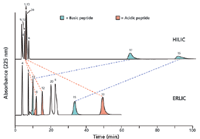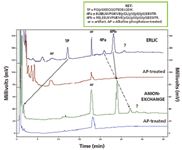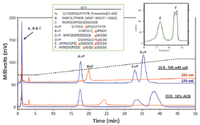Electrostatic Repulsion–Hydrophilic Interaction Chromatography: Using One Mode to Tune Retention from a Second Mode
LCGC North America
Electrostatic effects superimposed on hydrophilic interactions enables selection or deselection of functional groups for compound isolation.
When electrostatic effects are superimposed on hydrophilic interactions, specific functional groups can be selected (when the column has the opposite charge) or de-selected (when the column has the same charge). This can be exploited to isolate compounds, such as phosphopeptides, or to diminish the role of basic groups in solutes to enhance the selectivity for the rest of the molecule.
Hydrophilic interaction chromatography (HILIC) was presented as a general-purpose mode of chromatography in 1990 (1). It is now second only to reversed-phase chromatography as a method for analysis by high performance liquid chromatography (HPLC). Studies of the mechanism generally confirm that it involves partitioning of analytes between the mostly organic mobile phase and a stagnant layer of water of hydration associated with the hydrophilic stationary phase. If the stationary phase has an electrostatic charge, then mixed-mode effects from this will be superimposed upon the hydrophilic interaction. A particularly useful combination involves the use of an ion-exchange column with the same charge as most of the analytes and a high concentration of organic solvent (HILIC conditions). In the absence of the organic solvent, the resulting electrostatic repulsion would normally cause exclusion of the analytes from the pore volume, leading to elution before the dead volume of the column. However, as hydrophilic interaction is independent of electrostatic effects, with sufficient organic solvent the solutes are retained despite the electrostatic repulsion. This combination is termed electrostatic repulsion–hydrophilic interaction chromatography (ERLIC) (2).
Experimental
Chromatography was performed on an Essence HPLC system from Scientific Systems Inc./Lab Alliance (State College, Pennsylvania). Polyhydroxyethyl A, Polywax LP, and Polysulfoethyl A columns were obtained from PolyLC Inc. (Columbia, Maryland). All pore diameters were 300 Å.
The β-casein sample was digested with TPCK-treated bovine trypsin without reduction or alkylation. A portion of the digest was further treated with alkaline phosphatase (labeled AP-treated). Peaks were collected manually and peptides were identified via matrix-assisted laser desorption–ionization mass spectrometry (MALDI-MS).
Extract of whole rat kidney was reduced, alkylated, and digested with trypsin. The digest was desalted on a C18 solid-phase extraction (SPE) cartridge and 2 mg of peptides was applied to the ERLIC column and run as described in reference 12.

Figure 1: HILIC versus ERLIC for separation of peptide standards. Flow rate = 1 mL/min; mobile phase = 20 mM sodium methylphosphonate (pH 2.0) with % acetonitrile as indicated. HILIC: Column = Polyhydroxyethyl A (200 mm à 4.6 mm,5 µm); mobile phase = 63% acetonitrile. ERLIC: Column: Polywax LP (100 mm à 4.6 mm, 5 µm); mobile phase = 70% acetonitrile (2).
Results and Discussion
The electrostatic repulsion effect can be exploited in a number of ways. Basic peptides are much better retained than neutral or acidic peptides on a neutral HILIC column (Figure 1). Separation in such cases normally requires a gradient. However, if HILIC is performed on an anion-exchange column, then the repulsion selectively antagonizes the retention of the basic peptides. They then are eluted in the same time frame as the other peptides (Figure 1). This ability to tune down the retention of the best-retained components means that many mixtures can be resolved using isocratic conditions rather than a gradient. A dramatic example is shown in Figure 2: the isocratic resolution of all the common nucleotides in less than 35 min. In this case the components that were best-retained in HILIC were the triphosphorylated nucleotides, so a cation-exchange material was chosen to antagonize their retention selectively.

Figure 2: ERLIC of nucleotides. Column: Polysulfoethyl A (200 mm à 4.6 mm, 5 µm); mobile phase = 80 mM triethylamine phosphate (TEAP) (pH 3.0) with 84% acetonitrile; flow rate = 2 mL/min (2).
Two alternative, but related, approaches have been described for tuning up the role of the glycan in retention of tryptic glycopeptides in HILIC. Carr (3) performed HILIC at pH 6.5 on a neutral column. At this pH, carboxyl groups in peptides are charged and tend to neutralize the basic residues, diminishing their considerable role in promoting retention in HILIC. Alternatively, Ding et al. (4) performed HILIC with HCl or trifluoroacetic acid in the sample solvent. Trifluoroacetic acid forms a neutral, hydrophobic ion pair tenaciously with basic residues. Both methods resulted in fairly good separation of glycopeptides from nonglycopeptides in tryptic digests, although not to the extent that seems to be true of ERLIC.

Figure 3: ERLIC versus anion-exchange for the tryptic digest of β-casein. Column for both modes was Polywax LP (100 mm à 4.6 mm, 5 µm,). ERLIC mobile phases: mobile phase A = 20 mM sodium methylphosphonate (pH 2.0) with 70% acetonitrile; B = 200 mM TEAP (pH 2.0), containing 60% acetonitrile. Anion-exchange mobile phases: Same as with ERLIC but with 10% acetonitrile. Gradient: 0% B for 5 min, 0â100% B over 20 min, 10 min at 100% B; flow rate = 1 mL/min; detection = 220 nm.
Proteomics applications. An alternative arrangement in ERLIC is to repel everything in a mixture except for components that you wish to isolate. This approach is proving to be particularly useful in proteomics. It is usually implemented with an anionexchange column operated at a pH below 4. Under these conditions carboxyl groups are uncharged and peptides have a net positive charge. With 70% acetonitrile in the mobile phase, the electrostatic repulsion and hydrophilic interaction for most tryptic peptides is roughly in balance, and they elute in or near the void volume. Peptides with phosphate groups or glycopeptides with sialic acid residues retain negative charge under these conditions and are selectively retained. An example is shown in Figure 3. A tryptic peptide with one phosphate is scarcely better retained in the anion-exchange mode than the tryptic peptides with no phosphates, reflecting the electrostatic repulsion of the positively charged ends of the peptide. However, when hydrophilic interaction is superimposed on the same column in the ERLIC mode, the hydrophilicity of the phosphate group — combined with its attraction to the stationary phase — is sufficient to move it well away from the unmodified peptides. A number of groups have now exploited this combination to isolate phosphopeptides (5–10) and glycopeptides (6,11) from tryptic digests. ERLIC has a significant advantage over affinity methods such as immobilized metal ion affinity chromatography (IMAC) or metal oxide (titania; zirconia) adsorption for isolation of such peptides. Although the attraction to the modifying group is sufficient to pull them away from most of the unmodified peptides, it is not so strong that it dominates the chromatography completely. Consequently, phosphopeptides and glycopeptides can be resolved from each other with high resolution in the same step as their isolation, a major advantage in a multidimensional fractionation. Figure 4 shows a set of singly phosphorylated peptides with tryptic sequences being resolved in a volatile solvent.

Figure 4: ERLIC of phosphopeptides with volatile solvents. Column = Polywax LP (100 mm à 4.6 mm, 5 µm); mobile phase A = 20 mM ammonium formate (pH 2.2) with 70% acetonitrile; B (top) = 100 mM ammonium formate (pH 2.2) with 64% acetonitrile, or mobile phase (Bottom) = 20 mM ammonium formate (pH 2.2) with 10% acetonitrile. Gradient = 0% B for 5 min, 0â100% B over 40 min, 5 min at 100% B; flow rate = 1 mL/min (13).
At higher levels of acetonitrile, the hydrophilic interaction is strong enough to cause the retention of all peptides in a tryptic digest, despite the electrostatic repulsion. Under the right conditions, a decreasing gradient of both acetonitrile and pH leads to the elution of peptides in order of decreasing isoelectric point (pI) in a volatile solvent (Figure 5) without the need for ampholines or other buffering agents; as the hydrophilic interaction is tuned down, the electrostatic repulsion from the anion-exchange column determines the order of elution. A two-dimensional ERLIC-reversed-phase chromatography sequence results in 30–40% more peptide and protein identifications than are obtained with the cation exchange–reversed phase chromatography sequence now commonly used to fractionate complex protein digests in bottom-up proteomics (12). In the case of extremely basic or hydrophobic peptides, the increase is greater than 120%. These improvements in identifications suggest that in many applications ERLIC may supersede strong cation exchange as a first dimension in proteomics fractionations.

Figure 5: Rat kidney homogenate tryptic digest: Fractionation via ERLICâreversed phase versus strong cation exchangeâreversed phase (12).
Orientation Effects. The phosphopeptides in Figure 4 are eluted in order of proximity of the phosphate group to the C-terminus. This is not a coincidence. Tryptic peptides tend to migrate through an anion-exchange column in an oriented manner, with the C-terminus facing the stationary phase (13). The closer the phosphate group is to the C-terminus, the greater its ability to interact with the stationary phase. Both ends of a tryptic peptide have basic groups that repel the stationary phase in ERLIC or in anion-exchange chromatography. However, the basic sidechain of the arginine or lysine residue at the C-terminus is in a zwitterionic bond with the carboxyl group of the C-terminus, lessening its repulsion compared with that experienced by the N-terminus. This is sufficient to orient the binding of the peptide. The same effect serves to orient tryptic peptides in the opposite manner on a cation-exchange material, as illustrated in the schematic in Figure 6. Orientation effects provide a satisfactory explanation for the ability of an ion-exchange column to separate positional variant peptides, or other charged solutes with the same charge-to-mass ratio but different spatial arrangement of charge. ERLIC is more sensitive to such things than a neutral column in HILIC.

Figure 6: Hypothetical orientation of tryptic phosphopeptides (13).
Tuning Repulsion Effects Up or Down. At levels of organic solvent much above 70%, hydrophilic interaction is so strong that electrostatic effects play a minor role. A decreasing organic gradient tunes down the hydrophilic interaction and the electrostatic repulsion in ERLIC can then cause elution of charged solutes with no need for a salt gradient. The effect is analogous to an immobilized salt gradient on an ion-exchange column. There are some special cases worthy of attention. At a pH high enough for phosphate groups to acquire a second negative charge, the level of repulsion is so high that no amount of organic solvent will suffice to get ATP retained by a cationexchange column. Also, some nominally neutral materials for HILIC will manifest electrostatic effects if the mobile phase contains less than 20 mM salt or other electrolyte. That figure appears to be the minimum needed for formation of a complete electrical double layer on the surface of a charged stationary phase (2).
Conclusions
While mixed-mode effects are common in chromatography, the combination used in ERLIC promises a number of advantages. The two modes involved are convenient to manipulate independently. This is not true of some combinations such as hydrophobic interaction chromatography (HIC) and ion exchange, where the decreasing salt concentration that decreases retention in one mode increases it in the other one at the same time. Like ion-exchange chromatography, the ERLIC approach is sensitive to charged functional groups in an analyte. Unlike ion exchange, the use of electrostatic repulsion means that one doesn't need high concentrations of salt to elute highly charged analytes in most cases. This may be useful for topdown proteomics analysis of intact proteins, for which the problem is frequently difficulty in getting them to elute with volatile solvents. The orientation effects also offer advantages over regular HILIC with regard to selectivity for charged analytes. ERLIC will increasingly be used for both selective and general fractionations in proteomics, and may prove to be a useful subset of HILIC for analysis of small charged solutes.
References
(1) A.J. Alpert, J. Chromatogr. 499, 177–196 (1990).
(2) A.J. Alpert, Anal. Chem., 80(2), 62–76 (2008).
(3) S. Carr (Glycobiology 1993 conference and personal communication).
(4) W. Ding et al., Mol. Cell. Proteomics 8(9), 2170–2185 (2009).
(5) C.S. Gan et al., J. Proteome Res. 7(11), 4869–4877 (2008).
(6) H. Zhang et al., Mol. Cell. Proteomics 9(4), 635–647 (2010).
(7) M.V. Bennetzen et al., Mol. Cell. Proteomics 9(6), 1314–1323 (2010).
(8) B. Razani et al., Sci. Signal. 3(123), ra41 (2010).
(9) Chen et al., J. Chromatogr. B, doi:10.1016/j.jchromb.2010.11.004 (2010).
(10) T. Guo et al., Cell. Mol. Life Sci., doi:10.1007/s00018-010-0545-x (2010).
(11) U. Lewandrowski et al., Clin. Proteom. 4(4), 25–36 (2008).
(12) P. Hao et al., J. Proteome Res. 9(9), 3520–3526 (2010).
(13) A.J. Alpert et al., Anal. Chem. 82(12), 5253–5259 (2010).
Andrew Alpert received his PhD degree in biochemistry under Fred Regnier (Purdue University). He started PolyLC Inc. in 1985 to manufacture HPLC columns for life science applications. He focuses on developing new modes of chromatography and adapting them to solving current problems in biochemistry. Amos Heckendorf, PhD, founder of The Nest Group, Inc., has over 40 years of experience in natural product and biomolecule separations. He specializes in supporting separation scientists to understand and solve unusual separation problems.

New Study Reviews Chromatography Methods for Flavonoid Analysis
April 21st 2025Flavonoids are widely used metabolites that carry out various functions in different industries, such as food and cosmetics. Detecting, separating, and quantifying them in fruit species can be a complicated process.
Extracting Estrogenic Hormones Using Rotating Disk and Modified Clays
April 14th 2025University of Caldas and University of Chile researchers extracted estrogenic hormones from wastewater samples using rotating disk sorption extraction. After extraction, the concentrated analytes were measured using liquid chromatography coupled with photodiode array detection (HPLC-PDA).

.png&w=3840&q=75)

.png&w=3840&q=75)



.png&w=3840&q=75)



.png&w=3840&q=75)















